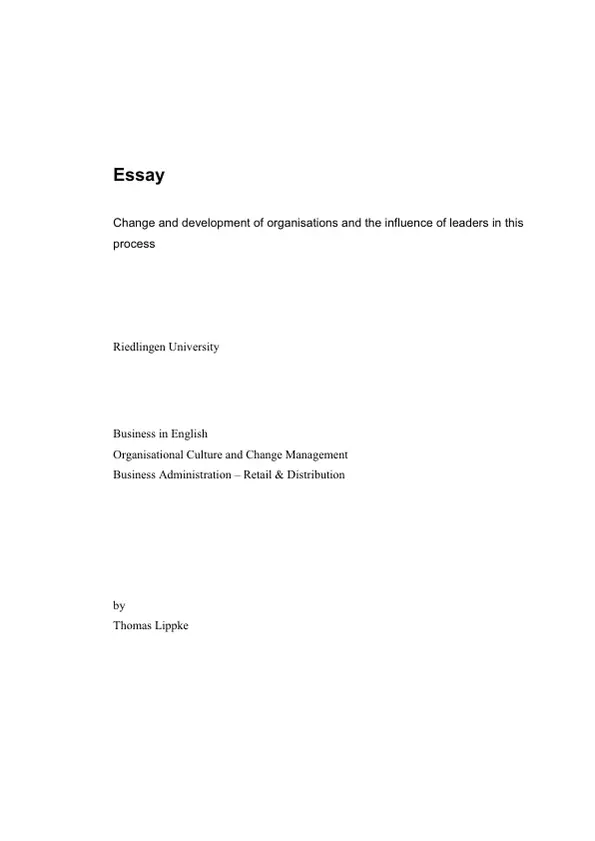Today the environment of organisations like companies, corporations under public law or any other society or association is in motion. The environmental factors are changing and afford more and more attention. Greatest booster of this process is known as “globalisation”. Globalisation has become the keyword in describing the challenges a company has to take nowadays. In detail this means, that the world market is sticking together. Everything is connected a little bit more every day. There are no separated markets that are split off of being involved in a worldwide competition anymore. So any enterprises, even small business, have competitors all around the world and need to focus on that. This is the development about the competition on one hand. On the other hand there are also different situations than before concerning customers, shareholders, stakeholders, employees, public and ecology. Every group has different interests and issues. Customers are getting more individual and they have higher expectations about product quality and variety while companies are trying to standardize and slim down their production. Investors are watching financial operating numbers. Their primary concerns are hard facts like liquidity, profitability or productivity. The factors public and ecology often cohere and affect organisations when ecological concerns take a back seat to industrial ones, for example. Employees first of all want to get an attractive salary. But they also need personal development inside of the organisation. The human needs are one of the main factors of success. If job satisfaction and motivation can be generated the company can benefit from full potential of leaders, workers and employees. To face this change process and successful combine all these factors an organisation also has to change. This organisational change has to take place on all levels of an organisation from top-management to leaders, to employees and even the physical structure. Driving change within an organisation is a difficult task because people and also their attitudes have to be moved and changed, too. In this context this work wants to show what organisational change means in detail and how it can be realised using scientific perceptions about organisations, leadership and human resources.
Inhaltsverzeichnis (Table of Contents)
- Introduction
- Interrogation and ambition of this essay
- Explanation of structure and content of this essay
- Theoretical background
- Organisations and organisational culture
- Change and development
- Personal traits and needs of employees
- Leader's contribution to promote change
- Managerial styles
- Change Management and methods of change processes
- What leaders do and how they do it
- Pros and cons
- Advantages and disadvantages of leader's impact on change
- The difference between "bottom-up" and "top-down"
- Summary
- Own opinion about the possibilities of leaders
Zielsetzung und Themenschwerpunkte (Objectives and Key Themes)
This essay aims to explore the complexities of organizational change and development, particularly focusing on the influence of leaders in driving this process. It delves into the theoretical underpinnings of organizations, change, and leadership, examining how these factors interplay in shaping organizational outcomes. Key themes explored in the essay include:- The impact of globalization on organizational change
- The role of organizational culture in fostering and hindering change
- The impact of different leadership styles on change processes
- The importance of considering both "bottom-up" and "top-down" approaches to change
- The benefits and drawbacks of leadership influence in driving organizational change
Zusammenfassung der Kapitel (Chapter Summaries)
The introductory chapter sets the stage by highlighting the dynamism of contemporary organizational environments, particularly in the context of globalization. It underscores the need for organizations to adapt and evolve to navigate the complex challenges of a globalized marketplace, noting the diverse perspectives and needs of various stakeholders, including customers, investors, employees, and the public. The subsequent chapter delves into the theoretical underpinnings of organizational change and development. It defines the concept of an organization, exploring different interpretations and highlighting the importance of organizational culture as a shared set of values, beliefs, and assumptions that influence members' behavior. The chapter further examines the individual employee, acknowledging the significance of their personal needs and motivations in driving organizational success. The third chapter focuses on the crucial role of leadership in promoting organizational change. It analyzes different managerial styles and their impact on employees and organizational outcomes. The chapter then introduces the concept of Change Management, a comprehensive approach to managing change processes, exploring various methods and techniques employed to facilitate successful change. The fourth chapter examines the pros and cons of leadership influence on change processes. It delves into the potential benefits and challenges associated with different approaches, comparing and contrasting "bottom-up" and "top-down" methods of implementing change.Schlüsselwörter (Keywords)
The essay explores organizational change and development, focusing on the influence of leaders in this process. Key keywords include: organizational culture, globalization, leadership styles, Change Management, "bottom-up" and "top-down" approaches, employee needs, and stakeholder perspectives.- Quote paper
- Thomas Lippke (Author), 2011, Organisational Change and Change Management, Munich, GRIN Verlag, https://www.grin.com/document/213658



